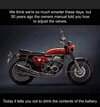Let me help you with the "cringe"... the brake rubber lines are actually double wall and the inside is made of EPDM rubber which, if you look in the chemical compatibility table for EPDM it does not readily react with the chemical in the automotive parts cleaner.
Also, the exposure time was minimal as the lines were dried with compressed air to remove all inside debris.
So... it's all good.
What bothers me however, is that I don't know your methods to clean brake lines (or anything else for that matter) because everything is handled via the phone. It just seems that you're critical of everybody else but you keep your cards close.
Check this out...

Straight out of the Honda Repair Manual, and it seems to work because my brakes are working. And you don't say why you think it doesn't do a good job, can you detail?
So, the manual recommends to bleed SMC at the PV port, the hydraulic diagram shows the SMC discharges in the PV, and yet my bleeding at the PV is not correct? Can you detail why?
So you see what's going on here?
Cheers and lots of beers...
Ok, I'll play.... I have many folks tell me that the Honda Service manual INSTRUCTS them to use a commercially available air bleeder to flush and bleed the system, and that is the only way to do it properly (per Honda). Well, lets look at that for a minute, First off, the Factory service manual does not state that you have to use a commercially available air bleeder, if you read your manual carefully, you will see a paragraph stating something to the effect, that IF you are using a commercially available air bleeder, FOLLOW THEIR INSTRUCTIONS.
So with that out of the way, you've provided a perfect example in this post of why I want to work one on one with people.
You took one paragraph out of the service manual, for (1) bleeder, and implied that you bled the entire system out of that bleeder, or at least that's what the two or three people took from that when I showed them your post. So you see, someone may see your "wording" and not understand what you meant, or you may have bled/flushed the entire system incorrectly, I have no idea and am not trying to point fingers at anyone.
Someone may read your post and decide that they don't have to follow the correct sequence with the (7) bleed valves, and seriously screw things up, simply because you posted one paragraph out of the manual, and they may think its ok to do that. Besides that, the first several pages that show your paragraph (for each and every bleeder) instructs you to drain the entire system, then rebuild all the calipers etc.
A few pages past that, it goes into how to add fluid and bleed things.
Many folks reach out to me after they completely drain all the fluid out, then can't bleed or get the air out etc.
So, in your words "see what's going here?"
For many more years than I care to admit, I've seen master Honda tech's insist that you can use VICE GRIPS to clamp down on a brake line to "get a better bleed".
I'm not of the camp where you can clamp anything on a hydraulic line of any kind, but that's just me.
I've also see folks flush out lines and end up with rubber crumbling inside the lines (very common issue with BMW brake lines) and jamming up stuff.
So, again, I don't flush out brake lines with chemicals, nor use clamps, but that's just me.
Many Honda service manuals also instruct you to replace all the hydraulic lines every four years or so, do folks do that? I doubt it, but it is written somewhere.
I'm not critical of ANYONE, only the Advice/Instructions that I provide.
And as far as keeping my cards close, I do have several decks of cards in my tool box to do magic tricks for the folks who come through the garage

I have always asked/requested that folks post pictures of problems found, and repairs made AFTER the work was finished to help other folks on the forum.
Why does everyone think I'm hiding something?
I spend several hours each and every day on the phone, often fielding as many as 15 to 20 calls a day, trying to assist and help folks, so exactly how am I keeping things from folks?
You have a question, call me

I'd be glad to talk to you.




